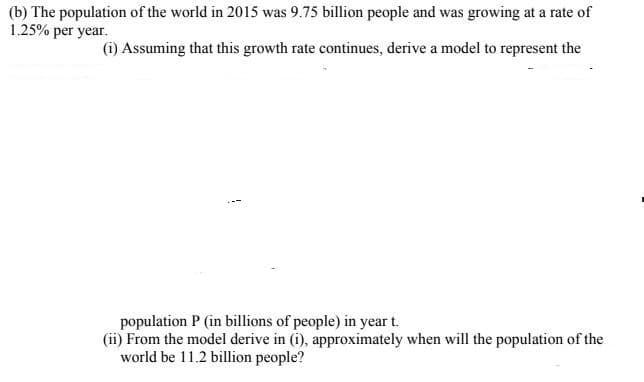(b) The population of the world in 2015 was 9.75 billion people and was growing at a rate of 1.25% per year. (i) Assuming that this growth rate continues, derive a model to represent the population P (in billions of people) in year t. (ii) From the model derive in (i), approximately when will the population of the world be 11.2 billion people?
(b) The population of the world in 2015 was 9.75 billion people and was growing at a rate of 1.25% per year. (i) Assuming that this growth rate continues, derive a model to represent the population P (in billions of people) in year t. (ii) From the model derive in (i), approximately when will the population of the world be 11.2 billion people?
Algebra & Trigonometry with Analytic Geometry
13th Edition
ISBN:9781133382119
Author:Swokowski
Publisher:Swokowski
Chapter5: Inverse, Exponential, And Logarithmic Functions
Section: Chapter Questions
Problem 18T
Related questions
Question

Transcribed Image Text:(b) The population of the world in 2015 was 9.75 billion people and was growing at a rate of
1.25% per year.
(i) Assuming that this growth rate continues, derive a model to represent the
population P (in billions of people) in year t.
(ii) From the model derive in (i), approximately when will the population of the
world be 11.2 billion people?
Expert Solution
This question has been solved!
Explore an expertly crafted, step-by-step solution for a thorough understanding of key concepts.
This is a popular solution!
Trending now
This is a popular solution!
Step by step
Solved in 3 steps with 3 images

Recommended textbooks for you

Algebra & Trigonometry with Analytic Geometry
Algebra
ISBN:
9781133382119
Author:
Swokowski
Publisher:
Cengage

Linear Algebra: A Modern Introduction
Algebra
ISBN:
9781285463247
Author:
David Poole
Publisher:
Cengage Learning


Algebra & Trigonometry with Analytic Geometry
Algebra
ISBN:
9781133382119
Author:
Swokowski
Publisher:
Cengage

Linear Algebra: A Modern Introduction
Algebra
ISBN:
9781285463247
Author:
David Poole
Publisher:
Cengage Learning
